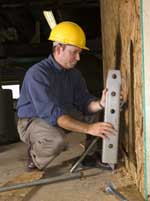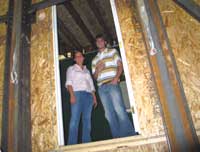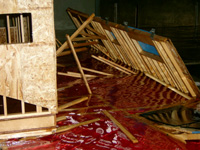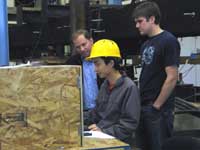Civil Engineers Give Homeowners More Say in Structural Design and Safety
 |
Today, new homeowners can upgrade every aesthetic aspect of their home from carpet and countertops to cabinets. Soon, thanks to the research and development of Dr. John van de Lindt, associate professor of civil engineering at Colorado State University, his colleagues and students, they will also be able to upgrade the structure of their home to withstand nature's worst disasters.
As evidenced by the 1994 Northridge earthquake, the '04 hurricane season and most recently Hurricane Katrina, wood frame structures, which account for approximately 90 percent of residential construction today, protect life safety but are severely damaged during hurricanes and earthquakes – often to the point of the owners financial ruin. To lessen the impact of such devastating storms on these ubiquitous structures, engineers at CSU are working to enable the construction industry -- builders, engineers and architects -- with the ability to implement performance-based design in the consumer market.
Performance-based design, a philosophy that allows clients to specify a required level of performance under certain loading or environmental conditions such as high winds, seismic activity, flooding and hurricanes, will provide for more choices in the home building process and subsequently safer, more sustainable structures. To do this, van de Lindt and colleagues have embarked on a large testing program to calibrate structural performance with design details.
“Currently, you can't buy a structural upgrade package when you buy a new house; but with performance-based design, you will be able to do that. For example, if you are living in the mountains of Colorado where there high wind gusts, you would be able to get the wind upgrade package,” says van de Lindt. “Right now we have the ability to explain how to incorporate these advanced design features into the structural plan, and within the next 6-7 years we plan to make these a choice. Interestingly, a home is often a persons' most valuable possession, yet they have little say in its performance.”

|
 |

|
Utilizing data gathered during their unprecedented earthquake shake table tests, van de Lindt and his research team have created SAPWood, a Seismic Analysis Package for Wood Frame Structures. SAPWood, a first-of-its kind program, provides researchers and practitioners with a user-friendly software package capable of performing nonlinear seismic structural and loss analysis for wood frame structures. A research tool, SAPWood allows the user to build, load, modify, and save a light frame wood structural model for various seismic-related analyses.
“This is the future of design codes, to give the owner some say in how they expect their building to perform during these extreme loading events,” said van de Lindt of the new design philosophy. “As storms increase in intensity, it will become even more important that this is being done.”
In addition to seismic research, van de Lindt and students are conducting research on other natural hazards such as floods and tsunami/hurricane-strength waves, and their effect on wood frame residential buildings. Having recently completed an American Society of Civil Engineers Special project outlining what needs to happen to enable performance-based design for wood frame structures in the next decade, the research team will be the first to address flood hazards.